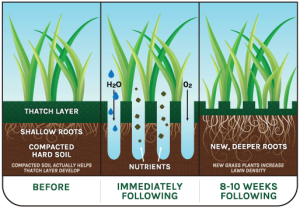With summer winding to a close, it’s time to concentrate on lawn recovery to ensure your grass returns with full force next spring. The best methods to accomplish this include dethatching, aerating and seeding your lawn. Once you learn why these steps are important and how to perform them, you’ll ensure a beautiful yard for years to come.
Dethatching Your Lawn
Most lawns experience areas where the grass dies just above the soil. Known as thatch, this layer of dead grass is beneficial in small amounts. However, when thatch builds up too quickly, it prevents water and air from reaching your grass, which can cause widespread brown patches.
How to Dethatch Your Lawn
Dethatching is a mechanical process that removes the inhibiting layer of dead grass for a healthier, greener lawn. You know it’s time for dethatching if more than a half-inch of dead grass has built up and begun to weaken your grass.
General dethatching tips:
- Water your lawn the day before you plan to dethatch.
- Mow your grass to half its normal height.
- Flag sprinkler heads and other hidden objects to prevent damaging them.
- Dethatch in two directions at a 90-degree angle from one another.
- If thatching leaves bare spots, reseed your lawn.
- Water the lawn well to help the grass recover.
- Aerate regularly in the future to prevent thatch build-up.
Dethatching your lawn with a convex rake:
If you only have a small patch of affected grass, a convex rake is an adequate dethatching tool. It can remove thatch up to 1-inch thick without placing too much stress on your lawn. The specialized rake features sharpened tines able to life thatch away from the soil surface.
When dethatching with a convex rake, use the same motion as traditional raking. Dig the tines into the thatch and pull upward to loosen and lift it out of the soil.
Dethatching your lawn with a power rake:
For larger spaces, you’ll undoubtedly refer a power rake, also called a vertical cutter or verticutter. You can rent a power rake from a hardware store if you want to complete the job yourself.
Be sure to ask if the blades are spaced properly for your type of grass. Also, ask the rental company to adjust the cutting depth so the blades go no deeper than one-half inch into the soil, if at all.
Be aware that this equipment is large and requires some muscle to maneuver. You’ll also need a truck to transport it to your home and a second person to help load and unload it.
Aerating Your Lawn
As time goes on, soil naturally compacts. Aeration perforates the soil to allow air, water and nutrients to reach grass roots. It also removes mild thatch. This helps roots grow deeper, making the lawn more vigorous and drought resistant. Your lawn may need to be aerated yearly if it’s subject to heavy foot traffic.
How to Aerate Your Lawn
You have two main tools to choose from for the job: a spike aerator and a plug aerator. While it may seem sufficient to poke holes in the soil with a spike aerator, this doesn’t remove any soil mass and may actually lead to increased compaction near the holes.
For the best results, use a plug aerator, which removes plugs of grass and soil 2 to 3 inches deep and 0.5 to 0.75 inches wide. You can rent such a machine from a garden store if you wish to perform the job yourself.
Aerating your lawn:
- Water your lawn the day before you plan to aerate the soil.
- Make a single pass over the whole lawn and multiple passes over especially compact areas.
- Allow the excavated soil plugs to dry, and then break them up with a lawn mower or the back of a rake.
- Continue basic lawn care practices, including fertilizing, mowing and watering.
Seeding Your Lawn
The summer heat often leaves grass looking pitiful and scorched. Dead brown patches or thinning sections certainly don’t add to your home’s curb appeal. Seeding can fill in bare patches and replace sections of dethatched grass for a more beautiful lawn next season. Even if your lawn is still healthy and green, overseeding can further fill out the grass and make it even lusher come spring.
Fall is the right time to seed your lawn because the cooler temperatures help new seeds retain moisture, germinate successfully and become established without battling extreme summer heat.
How to Seed Your Lawn
Start by reading the grass seed label to make sure you choose the right product for your lawn. You may want a seed blend that features two or more cultivars of the same species, such as fescue, in the same bag. This may help improve the appearance of your lawn.
Also, examine the coverage chart on the grass seed label to determine how much seed you should spread per square foot. Compare this to the drop rate of your broadcast or hand spreader to ensure you lay down the right amount of seed.
Overseeding an existing lawn:
- Mow the grass lower than usual.
- Dethatch and/or aerate the lawn, if needed, using the instructions in the above sections.
- Sprinkle the lawn with fertilizer.
- Apply the seed with a broadcast or hand spreader.
- Rake the seeds loosely.
- Water normally.
Fixing bare spots:
- Test whether the damage is caused by pests and take proper pest control measures if needed.
- Remove dead grass and rake the soil to loosen it.
- Spread grass seed.
- Rake the seeds loosely.
- Apply a thin layer of weed-free straw to help keep the seed and loose soil in place.
- Water the reseeded area frequently and shallowly to keep the soil moist without drowning or washing away the seeds.
If you’re uncertain about performing these important fall lawn care tips, you don’t have to do the job yourself. Whether you lack time, experience or confidence, count on The Grounds Guys® to complete these tasks for you!



